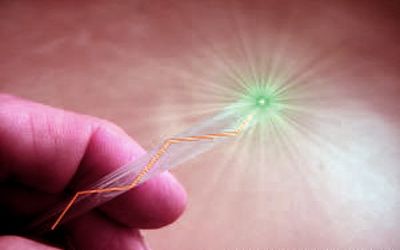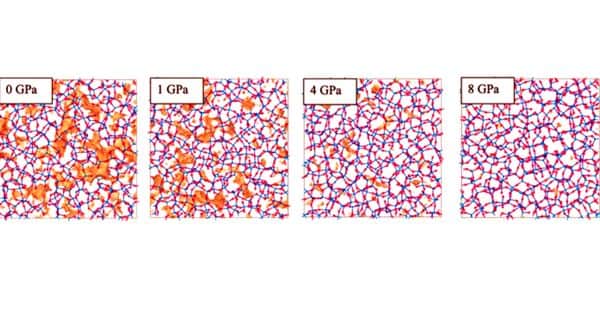Rapid, reliable communication is possible around the globe through fiber optic cables, but as good as they are, they are not flawless. Researchers from Penn State and AGC Inc. in Japan now say that the silica glass used by these cables would have less signal loss if it were made under high pressure. “Signal loss means that we have to use amplifiers every 80 to 100 kilometers (50 to 62 miles),” said John C. Mauro, Professor of Materials Science and Engineering at Penn State. “After that distance, the signal will not be identified properly. It’s going to be a huge deal across continents or across seas.”
With pressure treatment of the glass, the homogeneity of the material would increase, and the number of microscopic holes in the structure would decrease, creating a higher mean density and less variability.
According to research conducted by Penn State and AGC Inc. in Japan, silica glass for fiber optic applications can perform better when produced under high pressure. Researchers have found that this decreases the lack of signal in the material. Glass fibers lose signal power due to Rayleigh scattering—light scattering arising from variations in the atomic structure of glass. John C. Mauro, Professor of Materials Science and Engineering at Penn State, and his team used molecular simulations to test the use of pressure when constructing optical fibers, demonstrating that pressure quenching could minimize Rayleigh’s loss of dispersion by more than 50%. Rayleigh scattering occurs due to fluctuations in the glass’s atomic structure.
“Glass, on an atomic scale, is heterogeneous,” said Mauro. “It has an open porosity on an atomic scale that occurs randomly.”

The strands in fiber optical cables are made from ultra-high purity silica glass.
“Historically, the biggest breakthrough was the discovery that led to the original optical fiber—how to get rid of the water in the glass,” Mauro said. Normally, glass has a lot of water that absorbs the signal at the wavelengths typically used for telecommunications purposes. The fibers could be made clear of the water by using a modified method of chemical vapor deposition. But, like almost all glass, optical fibers are created under atmospheric pressure.
Mauro and his colleagues used molecular models to study the impact of strain on optical fibers. The findings were published in npj Computational Materials. The simulations found that Rayleigh’s scatter loss could be minimized by more than 50 percent by the use of pressure-quenching glass.
Pressure treatment of the glass will make the substance more homogeneous and reduce the microscopic gaps in the structure. This would result in a higher mean density substance and less uncertainty. In theory, Mauro and his team proved that pressure could increase the consistency of glass; Madoka Ono of AGC Inc.’s Materials Integration Laboratories and a professor at Hokkaido University’s Research Institute for Electronic Technology put the theory into effect. The findings were consistent with the simulation.
“We were looking for the independent processes that can control mean and variance,” said Mauro. “We realized that the pressure dimension had not been explored previously.”
Mauro’s thesis is a molecular simulation, but Madoka Ono of AGC Inc.’s Materials Integration Laboratories, an associate professor at the Research Center for Electronic Sciences at Hokkaido University in Japan, checked large sections of silica glass and found that the findings suited the simulation.
“The optimum pressure we found was 4 gigapascals,” said Mauro. “But there is still a process challenge that needs to be addressed.”
Mauro told Photonics Media that the technology wasn’t quite ready. “It’s likely, but we haven’t been there yet. We can get there about halfway with a macroscopic sample,” Mauro said.
In order to produce the optical fiber under pressure, the glass will have to be formulated and cooled under pressure when it is in the transformation process of glass—temperatures where the glass is sticky, not stable, and not really liquid. A pressure chamber capable of 40,000 atmospheres will be needed to do this.















